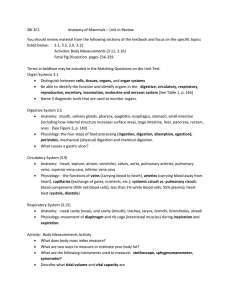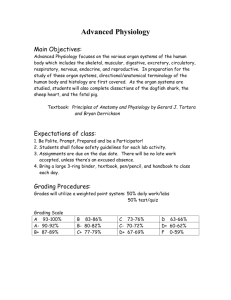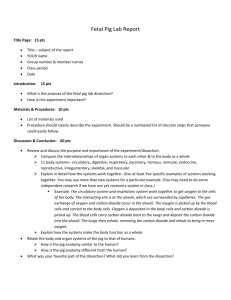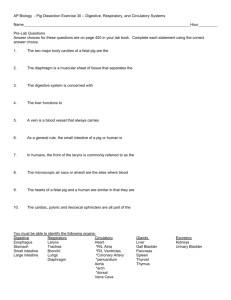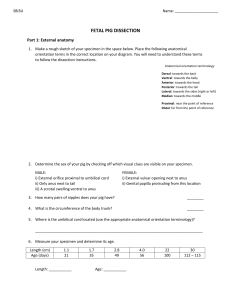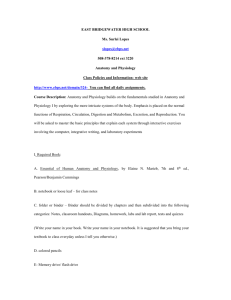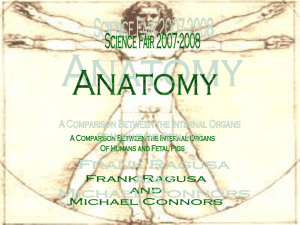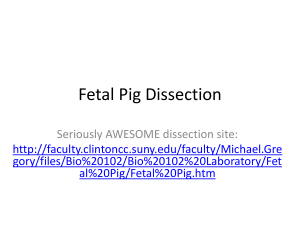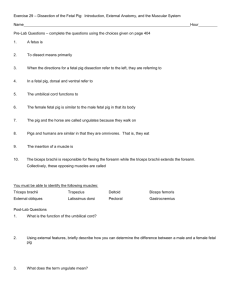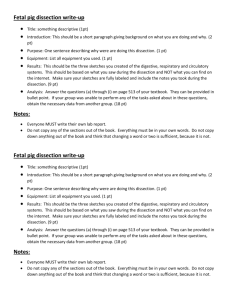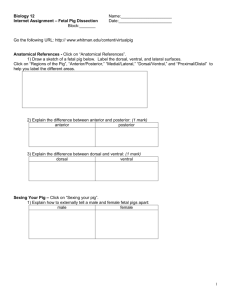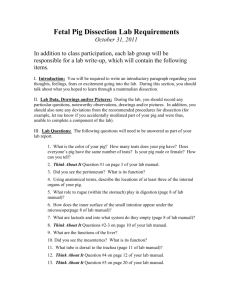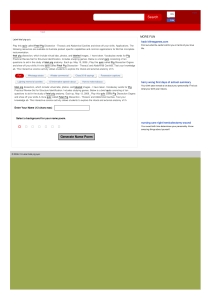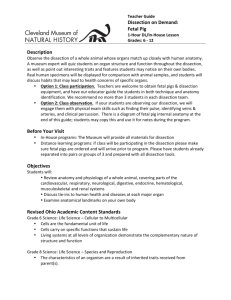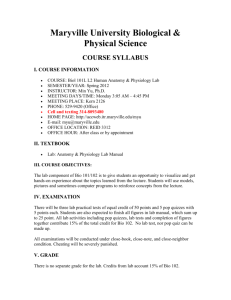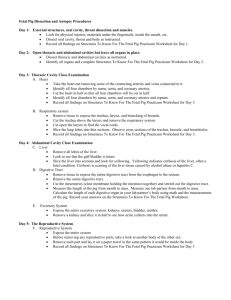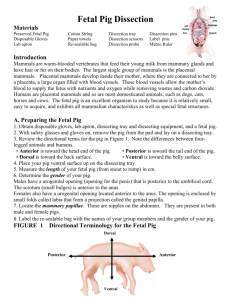Fetal Pig Dissection Summative
advertisement
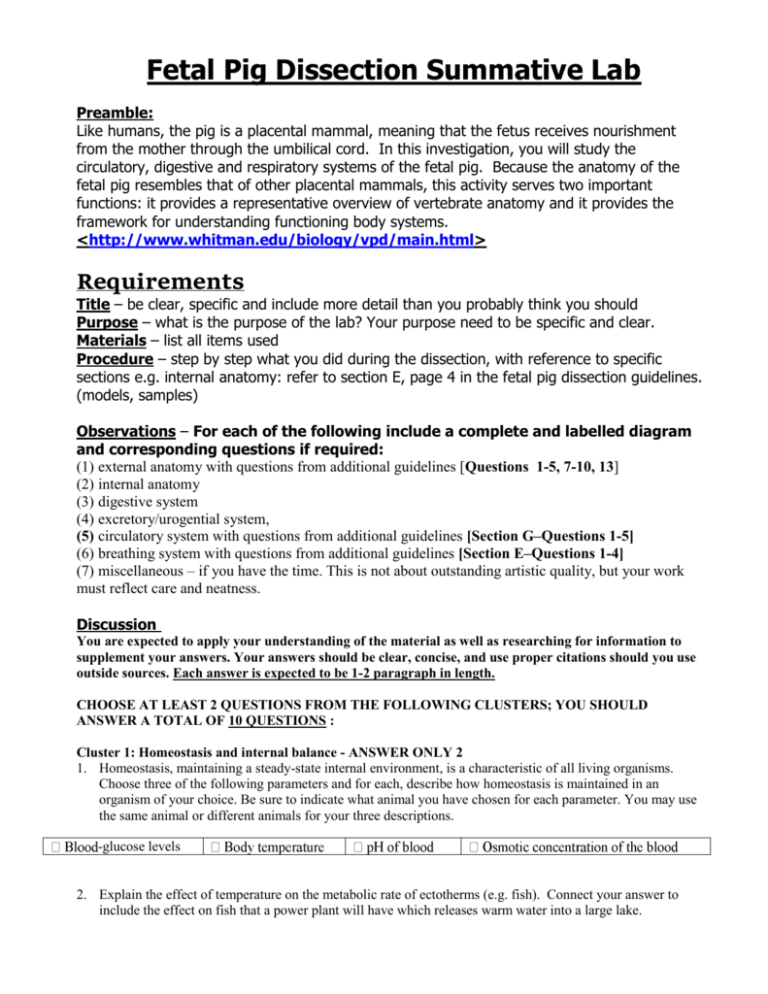
Fetal Pig Dissection Summative Lab Preamble: Like humans, the pig is a placental mammal, meaning that the fetus receives nourishment from the mother through the umbilical cord. In this investigation, you will study the circulatory, digestive and respiratory systems of the fetal pig. Because the anatomy of the fetal pig resembles that of other placental mammals, this activity serves two important functions: it provides a representative overview of vertebrate anatomy and it provides the framework for understanding functioning body systems. <http://www.whitman.edu/biology/vpd/main.html> Requirements Title – be clear, specific and include more detail than you probably think you should Purpose – what is the purpose of the lab? Your purpose need to be specific and clear. Materials – list all items used Procedure – step by step what you did during the dissection, with reference to specific sections e.g. internal anatomy: refer to section E, page 4 in the fetal pig dissection guidelines. (models, samples) Observations – For each of the following include a complete and labelled diagram and corresponding questions if required: (1) external anatomy with questions from additional guidelines [Questions 1-5, 7-10, 13] (2) internal anatomy (3) digestive system (4) excretory/urogential system, (5) circulatory system with questions from additional guidelines [Section G–Questions 1-5] (6) breathing system with questions from additional guidelines [Section E–Questions 1-4] (7) miscellaneous – if you have the time. This is not about outstanding artistic quality, but your work must reflect care and neatness. Discussion You are expected to apply your understanding of the material as well as researching for information to supplement your answers. Your answers should be clear, concise, and use proper citations should you use outside sources. Each answer is expected to be 1-2 paragraph in length. CHOOSE AT LEAST 2 QUESTIONS FROM THE FOLLOWING CLUSTERS; YOU SHOULD ANSWER A TOTAL OF 10 QUESTIONS : Cluster 1: Homeostasis and internal balance - ANSWER ONLY 2 1. Homeostasis, maintaining a steady-state internal environment, is a characteristic of all living organisms. Choose three of the following parameters and for each, describe how homeostasis is maintained in an organism of your choice. Be sure to indicate what animal you have chosen for each parameter. You may use the same animal or different animals for your three descriptions. -glucose levels 2. Explain the effect of temperature on the metabolic rate of ectotherms (e.g. fish). Connect your answer to include the effect on fish that a power plant will have which releases warm water into a large lake. 3. What is the function of lymph? How does it work? Cluster 2: Heart and Circulation - ANSWER ONLY 2 4. Trace a drop of blood through the human circulatory system starting and ending in the right atrium. 5. Name some adaptive advantages of the mammalian circulatory system (compare to a fish and amphibian). How do you think these adaptations benefit mammals? Why is the mammalian system of blood circulation considered the most efficient out of these examples? 6. Hormones are important in facilitating human life. Using evidence, give an example of a hormone that effect the heart and its function. Why is this hormone important? Cluster 3: Digestion and Nutrients - ANSWER ONLY 2 7. Trace a polysaccharide through the human digestive system. Explain what is happening at each of the main stages along the way. 8. Which of the sections of the small intestine are most important? Justify your answer with reasoning. 9. Explain why a 100% fat free diet is virtually impossible to attain, and why it might be an unhealthy choice. 10. What is glucagon and what is its function? How does its function compare to another pancreatic hormone, insulin? Cluster 4: Respiration and Breathing - ANSWER ONLY 2 11. Countercurrent flow aids gas exchange and temperature regulation. Explain how countercurrent flow in a fish’s gills is similar to what you would expect to find in the leg circulation of a penguin. 12. Trace the path taken by a molecule of O2 as it moves from the atmosphere outside the body arriving at a muscle cell. 13. What is diffusion and what are some factors that improves the efficiency of this process? Using an organism of your choice, explain how diffusion facilitates its respiratory processes. Cluster 5: Disease and Ethics - ANSWER ONLY 2 14. Describe a disorder related to the each of the respiratory, digestive, and circulatory systems. Include causes, symptoms, diagnosis, treatments, etc. 15. Do you agree with dissecting fetal pigs in high school? Consider opposing opinions, and justify your opinion based on evidence in at least two paragraphs. 16. Knowing how similar animals are to people, what is your opinion on euthanizing(mercy killing) animals that are sick, disabled, or abandoned? Justify your opinion based on evidence in at least two paragraphs. References Cited – include all references used in “Referencing in Science Guide” sheet. Make sure to include in-text citations in your discussion. Checklist November 9th: Read the fetal pig dissection guidelines and p. 308 – 312 of your textbook. Make yourself familiar with the additional guidelines as well. November 9-12: Create all labelled diagrams as required in class, and make additional touches to diagrams at home. Work on discussion questions at home. November 16th&17th: Work period in class on 16th and in computer lab on 17th. Submit final copy of your lab including all parts described above on Tuesday November 17th. Learning Skills and Work Habits Excellent Good I fully use this I use this learning learning skill/work habit to skill/work habit reach my potential to reach my in this course a lot potential in this of the time. course. Responsibility Learning Skills and Work Habits Satisfactory I know this skill/habit is important for me to reach my potential but I have to be reminded about it. Needs Improvement I don’t show that I know this skill/habit is important for me to reach my potential. - Does class work within the set timelines - Records own set of lab results during the lab - Takes responsibility for share of lab work and clean up - Follows lab procedures carefully and repeats steps, as necessary; does not take short-cuts or rush through the activity Organization - Comes prepared for lab activities by having read pre-lab materials -Respects deadlines by setting priorities - Asks specific questions when tasks are not clear Independent Work - Uses time wisely during work periods and respects classmates’ work time - Follows instructions with minimal supervision - Displays a positive work ethic Collaboration - Accepts equitable share of work in a group - Shares ideas and promotes critical thinking to develop ‘thinking’ questions for discussion Lab Report Marking Scheme Explanation Criteria Knowledge Level Title & Problem / Lab Technique / Observations/ Materials/Procedure Clear, concise direction is given to the lab through problem & title. Safe and competent skills are demonstrated throughout the lab. Thorough, high quality, qualitative labelled diagrams. There should be 7. Answers to questions within the observation section. 0 0 0 1 1 4 2 2 8 3 4 3 4 12 16 Inquiry Materials / Procedure Materials list is appropriate and complete. An elegantly designed set of procedures has been created based on all sources utilized. 0 0 1 2 2 4 3 6 Application Thorough answers to discussion questions. Insightful thoughts on the dissection controversy. Considers multiple opinions and justifies own opinion based on evidence. 0 0 5 2 10 15 20 4 6 8 Spelling, grammar, scientific terminology, presentation, organization and completeness. Complete works cited and in text citations in CSE format. 0 0 2 1 4 2 Discussion Questions Communication Level 4 – Excellent Level 3 – Good Level 1 – Limited Level 0 – Incomplete Level 2 – Satisfactory Total 6 3 /76 4 8 8 4

